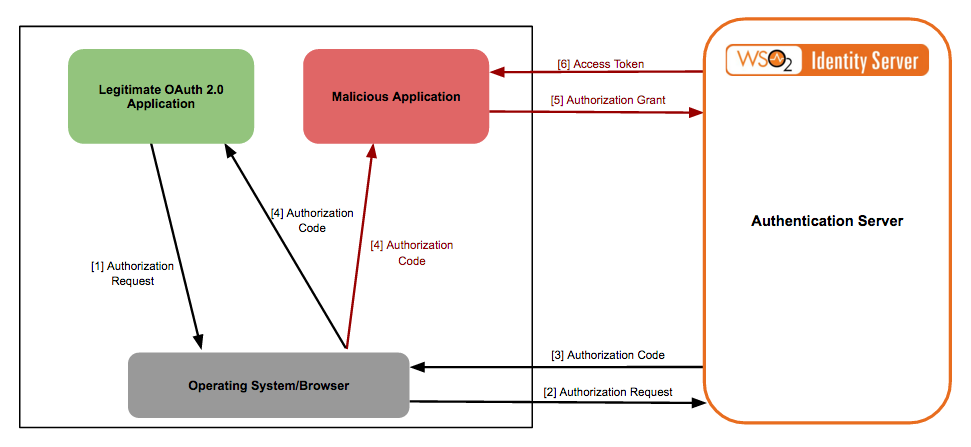Mitigate Authorization Code Interception Attacks¶
The following sections describe the impact of the code interception attack and the approaches you can use to mitigate it. You may need to mitigate these kinds of attacks when creating an OAuth application that uses the Authorization Code Grant type for authentication.
How can code interception attacks be harmful?¶
A code interception attack is where a malicious client intercepts the authorization code returned from the authorization endpoint and uses it to obtain the access token. OAuth is a popular mechanism for smartphone applications that run on platforms like Android, iOS, and Microsoft Windows. These applications generally use the Authorization Code grant type for authentication.
The authorization code grant type flow¶
-
The application is registered as a handler for a particular URI scheme (e.g., URLs beginning with "
org.wso2.app://"). This means that the application will launch whenever a user navigates to a URL beginning with the custom scheme "org.wso2.app://". -
When authentication is required, the application launches the system browser and loads the appropriate page of the identity provider. In this case, the identity provider is the WSO2 Identity Server (IS).
-
Within WSO2 IS:
-
The users authenticate themselves.
-
Approves any user consent regarding the application.
-
-
When the user is successfully authenticated, WSO2 IS redirects the user to the redirection URL provided by the application (e.g.,
org.wso2.app://auth?code=12345&state=abc). -
The browser queries the mobile Operating System (OS) to get a list of applications that handle the URI provided. The mobile OS determines the application(s) and parses the URI.
-
The native application extracts the authorization code from the parsed URI.
-
The native application sends the authorization code back to WSO2 IS, which validates the authorization code and returns the access token.
Since multiple applications can be registered as a handler for the specific redirect URI, the vulnerability of this flow is that a malicious client could also register itself as a handler for the same URI scheme that a legitimate application handles. If this happens, it is possible that the operating system will parse the URI to the malicious client. The flow of this attack is illustrated in the following diagram.
Info
In some operating systems such as Android, in step 5 of the flow, the user is prompted to select the application to handle the redirect URI before it is parsed using a "Complete Action Using" activity. This may prevent a malicious application from handling it, as the user can identify and select the legitimate application. However, some operating systems (such as iOS) do not have any such scheme.

Mitigate code interception attacks using PKCE¶
The WSO2 Identity Server supports the Proof Key for Code Exchange (PKCE) specification, which prevents applications from exchanging a maliciously obtained authorization code for an access token by introducing two new OAuth parameters to the normal flow of the authorization code grant type. PKCE is able to mitigate the attack while still being backward compatible with OAuth servers that do not support PKCE and without any changes to the existing flow.
With PKCE, the client sends the following two additional parameters when requesting an authorization code.
| Parameter | Description |
|---|---|
| code_challenge | The client creates and records a secret cryptographically random string (the code_verifier ), which is then encoded using URL-safe base64 encoding to transform it into the code_challenge. |
| code_challenge_method | This is the method used to transform the code_verifier into the code_challenge. It is sent as the hash algorithm name that was used for the hashing. When the authorization code is being issued, this method is used by the token endpoint to verify the code_verifier value. |
WSO2 Identity Server stores the values of the code_challenge and code_challenge_method parameters. When the client exchanges the authorization code for an access token, it passes the following additional parameter.
| Parameter | Description |
|---|---|
| code_verifier | The plain text cryptographically random string that was used to generate the code_challenge. |
WSO2 Identity Server then uses the code_challenge_method to transform the code_verifier sent and compares it with the code_challenge. If the comparison fails or no code_verifier is sent, WSO2 IS does not respond with an access token.
Configure PKCE with WSO2 Identity Server¶
To mitigate these attacks using PKCE with the WSO2 Identity Server, you need to enable PKCE when creating the OAuth application.